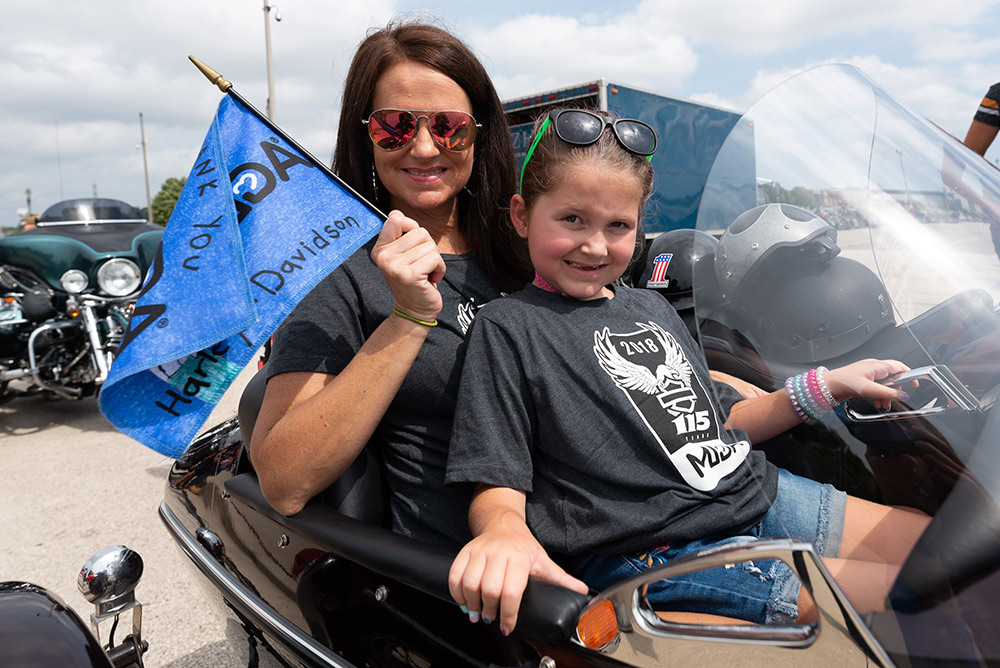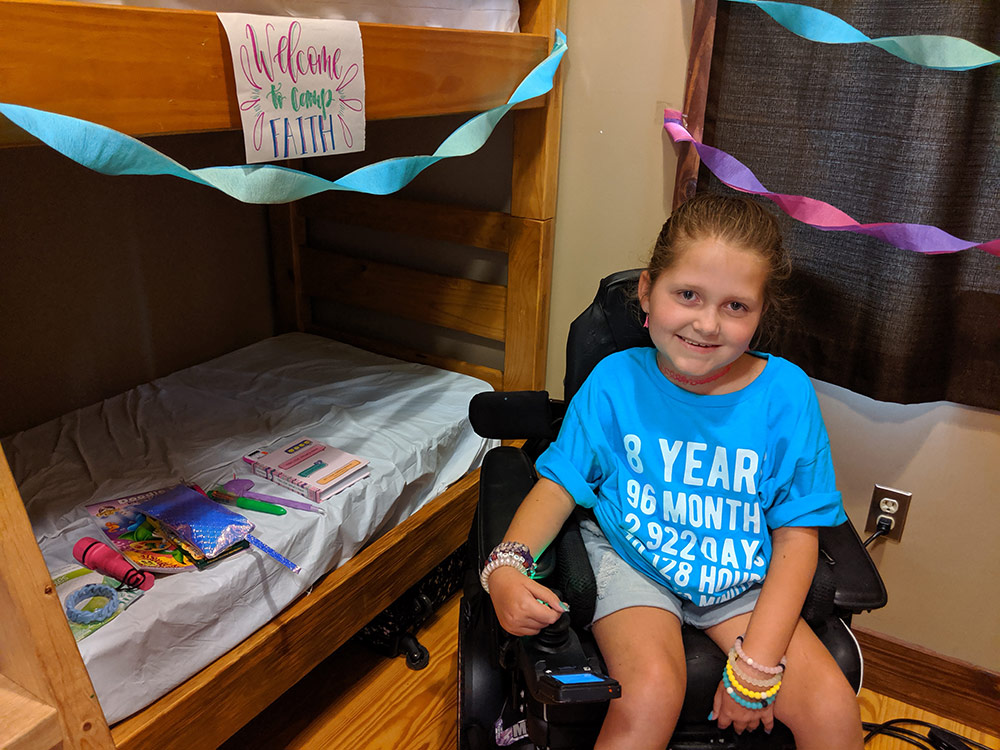2013年的一天,莉安·福滕貝里正開著車,接到了電話。
電話那頭是沃思堡一位醫生,先問了她在做什么之后,讓她把車停在路邊。醫生說,她的小女兒費思確診患有脊髓性肌萎縮癥(SMA),這是一種罕見的遺傳性神經肌肉疾病,病人的肌肉會逐漸萎縮。
她最怕的就是這個消息。費思18個月大的時候就開始有點不對勁。她都開始學說話了,還是站不起來。后來送去醫院會診,專業人士說只能希望不是脊髓性肌萎縮癥。然而驗血之后,之前的希望破滅了。
福滕貝里像所有聽到不幸消息的家長一樣提出問題:費思還有希望走路嗎?她能活下去嗎?
醫生說,不知道。
“我坐在路邊哭了一個小時。”她說。
如今費思已經8歲。雖然她的行動仍然受限,但在使用渤健公司(Biogen)針對脊髓性肌萎縮癥的藥物后,癥狀有所緩解,Spinraza是2016年美國首款批準的藥。趕上新冠病毒流行,她和母親的生活以及成千上萬與類似疾病抗爭的美國家庭生活遇到了新的挑戰。

脊髓性肌萎縮癥是神經肌肉疾病之一,相關疾病包括杜氏肌營養不良和肌萎縮側索硬化癥(ALS),或葛雷克氏癥(即漸凍人癥——譯注)等。
新冠病毒危機給患有類似疾病的患者造成了巨大挑戰。病人的健康面臨更大威脅,新藥開發節奏擾亂,護理人員的負擔也在增加。
“該類患者也是感染新冠的高風險人群之一。”肌營養不良協會(MDA)的主席兼首席執行官林恩·沃斯說。類似疾病會影響所有肌肉,其中也包括支撐肺部的橫膈膜,導致呼吸困難。而且,致命的呼吸系統疾病本來也容易危及生命。
“新冠病毒有可能導致他們死亡。”她說。
沃斯補充說,如果病人因為自身慢性病而需要緊急吸氧,但由于擔心感染新冠病毒,現在不可能指望急診室。
在美國,罹患脊髓性肌萎縮癥、肌萎縮側索硬化癥和各類肌營養不良癥的病人約27.5萬。由于患者的病情和疾病各不相同,從幼年到成年各種年齡都可能死亡。
據介紹,肌營養不良協會為非營利組織,也是聯邦政府以外最大的神經肌肉疾病藥物研發和患者護理研究資助機構,70多年投入了超過10億美元用于研發新的治療方法。
然而疫情期間,研究遭遇了重大挑戰。
“研發方面出現了很多慌亂局面。”莎倫·海斯特利說,她在生物制藥行業從業20年,現在擔任肌營養不良協會的首席研究官。“很多(臨床試驗)暫停。除非是緊急情況或手術治療,現在讓病人到醫院參加臨床試驗真的很難說通。”
對于神經肌肉疾病試驗正在進行中的機構來說,任務相當艱巨。有些機構在將治療試驗方案提交給美國食品與藥品管理局審批時,數據都不完整。向監管部門提交申請可能大大推遲。
問題還不僅限于罕見疾病。遭逢新冠危機,美國食品與藥品管理局推動了針對多種疾病的虛擬臨床試驗。然而,此舉對神經肌肉疾病患者群體造成的影響特別嚴重,因為照顧此類病人相當困難,尋求新治療方案非常重要。
但海斯特利說,面對逆境,肌營養不良協會的受助人也發揮了創造力。
判斷神經肌肉疾病治療效果有個關鍵指標是6分鐘步行測試。病人要在6分鐘內盡可能走路。由于目前無法在診所測試,一些小組已經將雙向攝像機送給研究參與者及護理人員。患者可以在家中觀察并記錄結果,在保證安全的前提下測試。
“正常情況下肯定不會這么做,但現在顯然不正常。”海絲特雷說,他聽說至少有兩個不相關的病人小組在使用該方法。
今年4月初,肌營養不良協會成立了新的醫療咨詢小組,就影響神經肌肉疾病患者研究和護理的各種課題發布指導意見。4月2日,肌營養不良協會的現任首席醫療顧問巴里·伯恩博士與首席宣傳官克里斯汀·斯蒂芬森在Facebook上舉辦了在線活動,探討病毒肆虐期間的好做法。參與人數驚人之多。
“在肌營養不良協會里,150位護理中心主任幾乎都來開會好幾個小時。”伯恩說。
在困難時期推動社區加強聯系確實是比較顯著的創新。但提出新試驗技術并舉辦虛擬會議能起到的作用有限,尤其是在患者及護理者的心理健康方面。
舉例來說,即便在正常情況下,患有杜氏癥的兒童也得找看護者幫忙翻身,防止肌肉損傷或患上褥瘡,因為他們自己無法翻身。
說回福滕貝里,身為教師的她既要上課,還要教女兒費思。疫情剝奪了母女外出與他人互動的機會。這對病人和照顧者來說是個沉重的打擊,他們變得更孤立也更難活動。

“流感季節,大多數脊髓性肌萎縮癥病友都足不出戶。但我們不會。我跟費思都很愛社交。”福滕貝里說。
她回憶起最近一次帶費思盡可能走出家門的情景:“我們坐在車庫里,向每個經過的人揮手致意。我們只想多接觸其他人。”
很大的遺憾是,今年費思不能再參加肌營養不良協會組織的夏令營了,這是她最喜歡的活動之一。但身為快樂的戰士,福滕貝里表示仍然很感激肌營養不良協會建立的虛擬營地。
“她能再見到她的朋友,我就很高興了。”福滕貝里說。(財富中文網)
譯者:Feb
2013年的一天,莉安·福滕貝里正開著車,接到了電話。
電話那頭是沃思堡一位醫生,先問了她在做什么之后,讓她把車停在路邊。醫生說,她的小女兒費思確診患有脊髓性肌萎縮癥(SMA),這是一種罕見的遺傳性神經肌肉疾病,病人的肌肉會逐漸萎縮。
她最怕的就是這個消息。費思18個月大的時候就開始有點不對勁。她都開始學說話了,還是站不起來。后來送去醫院會診,專業人士說只能希望不是脊髓性肌萎縮癥。然而驗血之后,之前的希望破滅了。
福滕貝里像所有聽到不幸消息的家長一樣提出問題:費思還有希望走路嗎?她能活下去嗎?
醫生說,不知道。
“我坐在路邊哭了一個小時。”她說。
如今費思已經8歲。雖然她的行動仍然受限,但在使用渤健公司(Biogen)針對脊髓性肌萎縮癥的藥物后,癥狀有所緩解,Spinraza是2016年美國首款批準的藥。趕上新冠病毒流行,她和母親的生活以及成千上萬與類似疾病抗爭的美國家庭生活遇到了新的挑戰。
脊髓性肌萎縮癥是神經肌肉疾病之一,相關疾病包括杜氏肌營養不良和肌萎縮側索硬化癥(ALS),或葛雷克氏癥(即漸凍人癥——譯注)等。
新冠病毒危機給患有類似疾病的患者造成了巨大挑戰。病人的健康面臨更大威脅,新藥開發節奏擾亂,護理人員的負擔也在增加。
“該類患者也是感染新冠的高風險人群之一。”肌營養不良協會(MDA)的主席兼首席執行官林恩·沃斯說。類似疾病會影響所有肌肉,其中也包括支撐肺部的橫膈膜,導致呼吸困難。而且,致命的呼吸系統疾病本來也容易危及生命。
“新冠病毒有可能導致他們死亡。”她說。
沃斯補充說,如果病人因為自身慢性病而需要緊急吸氧,但由于擔心感染新冠病毒,現在不可能指望急診室。
在美國,罹患脊髓性肌萎縮癥、肌萎縮側索硬化癥和各類肌營養不良癥的病人約27.5萬。由于患者的病情和疾病各不相同,從幼年到成年各種年齡都可能死亡。
據介紹,肌營養不良協會為非營利組織,也是聯邦政府以外最大的神經肌肉疾病藥物研發和患者護理研究資助機構,70多年投入了超過10億美元用于研發新的治療方法。
然而疫情期間,研究遭遇了重大挑戰。
“研發方面出現了很多慌亂局面。”莎倫·海斯特利說,她在生物制藥行業從業20年,現在擔任肌營養不良協會的首席研究官。“很多(臨床試驗)暫停。除非是緊急情況或手術治療,現在讓病人到醫院參加臨床試驗真的很難說通。”
對于神經肌肉疾病試驗正在進行中的機構來說,任務相當艱巨。有些機構在將治療試驗方案提交給美國食品與藥品管理局審批時,數據都不完整。向監管部門提交申請可能大大推遲。
問題還不僅限于罕見疾病。遭逢新冠危機,美國食品與藥品管理局推動了針對多種疾病的虛擬臨床試驗。然而,此舉對神經肌肉疾病患者群體造成的影響特別嚴重,因為照顧此類病人相當困難,尋求新治療方案非常重要。
但海斯特利說,面對逆境,肌營養不良協會的受助人也發揮了創造力。
判斷神經肌肉疾病治療效果有個關鍵指標是6分鐘步行測試。病人要在6分鐘內盡可能走路。由于目前無法在診所測試,一些小組已經將雙向攝像機送給研究參與者及護理人員。患者可以在家中觀察并記錄結果,在保證安全的前提下測試。
“正常情況下肯定不會這么做,但現在顯然不正常。”海絲特雷說,他聽說至少有兩個不相關的病人小組在使用該方法。
今年4月初,肌營養不良協會成立了新的醫療咨詢小組,就影響神經肌肉疾病患者研究和護理的各種課題發布指導意見。4月2日,肌營養不良協會的現任首席醫療顧問巴里·伯恩博士與首席宣傳官克里斯汀·斯蒂芬森在Facebook上舉辦了在線活動,探討病毒肆虐期間的好做法。參與人數驚人之多。
“在肌營養不良協會里,150位護理中心主任幾乎都來開會好幾個小時。”伯恩說。
在困難時期推動社區加強聯系確實是比較顯著的創新。但提出新試驗技術并舉辦虛擬會議能起到的作用有限,尤其是在患者及護理者的心理健康方面。
舉例來說,即便在正常情況下,患有杜氏癥的兒童也得找看護者幫忙翻身,防止肌肉損傷或患上褥瘡,因為他們自己無法翻身。
說回福滕貝里,身為教師的她既要上課,還要教女兒費思。疫情剝奪了母女外出與他人互動的機會。這對病人和照顧者來說是個沉重的打擊,他們變得更孤立也更難活動。
“流感季節,大多數脊髓性肌萎縮癥病友都足不出戶。但我們不會。我跟費思都很愛社交。”福滕貝里說。
她回憶起最近一次帶費思盡可能走出家門的情景:“我們坐在車庫里,向每個經過的人揮手致意。我們只想多接觸其他人。”
很大的遺憾是,今年費思不能再參加肌營養不良協會組織的夏令營了,這是她最喜歡的活動之一。但身為快樂的戰士,福滕貝里表示仍然很感激肌營養不良協會建立的虛擬營地。
“她能再見到她的朋友,我就很高興了。”福滕貝里說。(財富中文網)
譯者:Feb
Leeann Fortenberry was driving when she got the call one day in 2013.
A doctor from Fort Worth was on the other end of the line and asked what she was doing. She needed to pull over to the side of the road, he told her. Fortenberry’s infant daughter, Faith, had been diagnosed with a form of spinal muscular atrophy (SMA), a rare genetic neuromuscular disease that wastes away its victims’ muscles.
This was her biggest fear. At 18 months old, Faith had shown signs that something was wrong. She was beginning to learn how to speak and yet had still not been able to stand. That led to a doctor’s consultation where professionals told her they just hoped it wasn’t SMA. A blood test had now dashed those hopes.
Fortenberry immediately began asking the questions any parent would with such distressing news: Would Faith ever walk? Would she even live?
The doctor said he didn’t know.
“I just sat and cried on the side of the road for an hour,” she says.
Faith is now 8 years old. While her mobility is limited, Biogen’s SMA treatment Spinraza, which became the first approved SMA drug in the U.S. in 2016, has helped. But the pandemic has added new challenges to her and her mother’s lives—as well as the lives of thousands of American families grappling with similar diseases.
SMA is one of a group of neuromuscular diseases that includes Duchenne muscular dystrophy and amyotrophic lateral sclerosis (ALS), or Lou Gehrig’s disease, among others.
The COVID-19 crisis presents potent challenges for patients with such conditions: posing an even greater danger to their health, disrupting the development of new drugs, and putting an added burden on caregivers.
“This population is among the highest risk for COVID,” says Lynn Vos, president and CEO of the Muscular Dystrophy Association (MDA). Such diseases can affect all muscles, including the diaphragm, which supports the lungs, making it difficult to breathe. A deadly respiratory illness on top of that is an existential threat.
“COVID would kill them,” she says.
Should a patient need emergency ventilation for their own underlying condition, the emergency room is about the last place they can turn to right now, owing to the risk of contracting the coronavirus, Vos adds.
SMA, ALS, and various types of muscular dystrophies collectively afflict about 275,000 people in the U.S. Depending on which condition—and which form of the disease—a patient has, they can die anywhere from early childhood to young adulthood.
The MDA, a nonprofit, is the largest funder of research into drug development and care for neuromuscular disease patients outside of the federal government, committing more than $1 billion to the discovery of new treatments over the course of more than 70 years, according to the organization.
That research has been a major challenge amid the pandemic.
“We’re having a lot of consternation on the research side,” says Sharon Hesterlee, a 20-year veteran of the biopharmaceutical industry who now serves as the MDA’s chief research officer. “Many [clinical trials] are on hold. Having these people come into a hospital for a clinical trial, unless it’s an emergency or intervention, you really can’t justify it right now.”
That’s a tough lift for organizations in the midst of conducting neuromuscular disease trials. Some may now have incomplete data when submitting an experimental therapy to the Food and Drug Administration for approval. Regulatory submissions could very well be delayed.
This isn’t an issue limited to rare disorders. The FDA has already been pushing for virtual clinical trials for a number of conditions in the face of the coronavirus crisis. It does, however, hit the neuromuscular disease community particularly hard given how difficult it can be to care for such patients—which makes the quest for new treatments so important.
But Hesterlee says that in the face of adversity, the MDA’s grantees are getting creative.
One key metric used to see whether or not a treatment for neuromuscular diseases is working is a six-minute walk test. A patient is asked to walk as far as possible in six minutes. Since these kinds of tests can’t be conducted in the clinic right now, some groups have begun sending two-way cameras to the homes of study participants and their caregivers. They then observe and record the test, which a patient can do from the safety of their own homes.
“You’d never do this in normal circumstances, but these clearly are not normal circumstances,” says Hesterlee, who’s heard from at least two unrelated patient groups that have switched to this method.
Earlier this month, the MDA formed a new medical advisory team to issue guidance on various topics that impact research and care for neuromuscular disease patients. Dr. Barry Byrne, now the MDA’s chief medical adviser, co-held a Facebook Live event with MDA chief advocacy officer Kristin Stephenson on April 2 regarding best practices during the coronavirus crisis. The turnout was stunning.
“All 150 of the care center directors in our MDA network came to the meeting virtually for several hours,” Byrne says.
The innovation driving this tight-knit community in a difficult time is striking. But coming up with new trial techniques and holding virtual town halls can only do so much—especially when it comes to the mental health of patients and their caregivers.
Even in normal circumstances, a child with Duchenne, for instance, may have to be physically turned over by their caregivers in their beds to prevent further muscle damage or bedsores since they likely can’t do so by themselves.
For Fortenberry, a schoolteacher who now has to teach her own classes as well as Faith, the pandemic has been a thief in the night, robbing mother and daughter of the chance to go outside and interact with others. That hits hard for patients and caregivers who typically are more isolated and less mobile to begin with.
“Most of our SMA friends tend to shut down and not leave their homes during flu season. We’ve never been like that. Faith and I are very social,” Fortenberry says.
She recalls a recent day when she and Faith did the closest thing they could to going outside: “We just sat in the garage and waved at every human that passed. We just want to be around folks again.”
One big regret is that Faith won’t be able to attend the summer camp set up by the MDA this year—one of her favorite activities. But, ever the happy warrior, Fortenberry says she’s still grateful for the virtual camp MDA is setting up instead.
“I’m just glad that she’ll get to see her friends again,” says Fortenberry.






